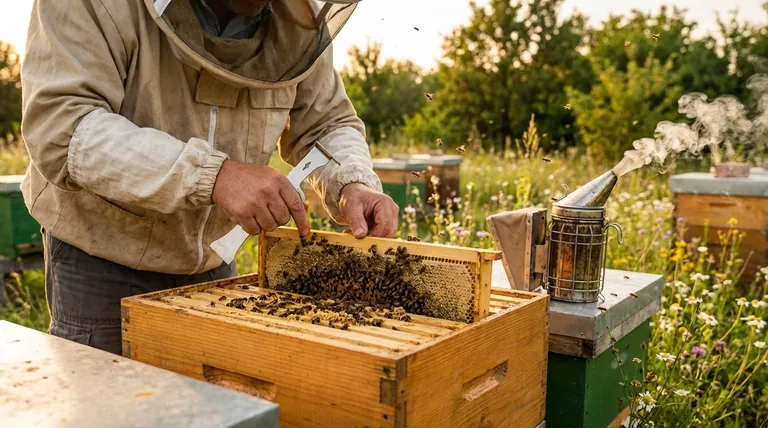Yes, absolutely. Beehive maintenance is a fundamental and non-negotiable responsibility of beekeeping. It is the practice of monitoring and managing the hive to ensure the colony remains healthy, productive, and stable within its environment.
The core purpose of hive maintenance is not to interfere with the bees, but to create the optimal conditions for the colony to thrive. It is a proactive process of ensuring bee health, managing space, and maintaining a secure environment.

Why Hive Maintenance is Crucial
A beehive is a complex, living system. While bees are remarkably self-sufficient, a beekeeper's regular attention can prevent problems that could otherwise devastate a colony.
To Ensure Colony Health
Maintaining tidy and stable conditions inside the hive is essential for the well-being of the bees. A clean environment helps prevent the spread of diseases and pests.
Healthy bees are better equipped to perform their duties, from foraging for nectar to caring for the queen and brood. This directly impacts the entire colony's vitality.
To Maximize Hive Productivity
Proper maintenance directly correlates with the hive's output. Healthy bees are productive bees, allowing them to function at their full potential.
Whether your goal is honey production, pollination, or simply supporting bee populations, a well-managed hive will always yield better results.
To Manage Space and Prevent Swarming
A primary task in hive maintenance is managing the available space. As a colony grows, it can run out of room, which often triggers its natural instinct to swarm—where the queen leaves with about half the bees to find a new home.
Regular checks allow you to add more boxes (supers) when needed, giving the colony room to expand and reducing the likelihood of swarming.
Common Maintenance Responsibilities
While the frequency and specifics can vary, most maintenance revolves around a few core activities.
Conducting Regular Inspections
This is the most common maintenance task. It involves briefly opening the hive to check for key health indicators: a healthy queen, a solid brood pattern, adequate food stores, and any signs of pests or disease.
Adjusting Hive Placement
A hive may need to be moved for a variety of reasons. This could be to avoid conflicts with people or to provide the bees with better access to forage.
Ensuring the hive is in a safe, stable, and suitable location is an ongoing part of a beekeeper's maintenance duties.
Committing to Continuous Learning
Effective maintenance requires knowledge. The best beekeepers constantly learn by reading, attending club meetings, and participating in forums.
This educational commitment is a form of proactive maintenance, as it prepares you to identify and solve problems before they become critical.
Making the Right Choice for Your Goals
Your approach to maintenance will depend on your specific objectives as a beekeeper.
- If your primary focus is hobbyist beekeeping: Concentrate on consistent, seasonal health checks and ensuring the bees have enough space to thrive.
- If your primary focus is operating in an urban area: Prioritize safe hive placement and regular monitoring to prevent any conflicts with neighbors or maintenance staff.
- If your primary focus is honey production: Your maintenance will be more intensive, focusing on optimizing space and colony strength to capitalize on nectar flows.
Ultimately, consistent hive maintenance is the practice that turns beekeeping into a rewarding and successful partnership with your bees.
Summary Table:
| Maintenance Activity | Key Purpose |
|---|---|
| Regular Inspections | Check for queen health, brood pattern, pests, and disease. |
| Managing Hive Space | Add supers to prevent swarming and support colony growth. |
| Adjusting Hive Placement | Ensure a safe, stable location with good forage access. |
| Continuous Learning | Proactively identify and solve problems through education. |
Ensure your apiary's success with professional-grade equipment from HONESTBEE.
Proper hive maintenance starts with durable, reliable gear. As a trusted wholesale supplier for commercial apiaries and beekeeping equipment distributors, HONESTBEE provides the robust equipment you need to perform essential checks and manage your colonies effectively.
Let us help you build a stronger, more productive operation. Contact our team today to discuss your wholesale needs and explore our full catalog of beekeeping supplies.
Visual Guide

Related Products
- HONESTBEE Advanced Ergonomic Stainless Steel Hive Tool for Beekeeping
- HONESTBEE 15-in-1 Beekeeper Multi-Tool with Hammer and Pliers for Beekeeping
- Professional Galvanized Hive Strap with Secure Locking Buckle for Beekeeping
- Versatile Ratchet Hive Strap with S-Hooks for Secure Fastening
- Lightweight Durable Plastic Queen Excluder Scraper for Beekeeping
People Also Ask
- Why is it important to compare the progress of different hives? A Beekeeper's Key Diagnostic Tool
- What is a hive tool and what are its uses? Master Your Hive Inspections with the Essential Beekeeper's Tool
- What is the hole in a hive tool for? A Multi-Tool for Apiary Repairs and Maintenance
- What are the features of a regular hive tool? The Essential Multi-Tool for Every Beekeeper
- Why do hive tools have a hole? Unlock the Secret to Efficient Beekeeping



















